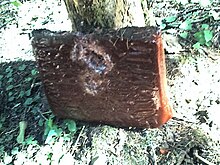Habbakuk project
|
||||||||||||
|
||||||||||||
|
|
||||||||||||
The Habbakuk Project was a World War II British plan for an aircraft carrier made from Pykrete , a mixture of ice and sawdust. It was supposed to be stationed in the middle of the Atlantic to protect the Allied convoys against the German submarines , as this area was then still beyond the reach of land-based Allied aircraft . The ship was never built.
Technical data and history
The ship was proposed to Winston Churchill by Lord Mountbatten and Geoffrey Pyke (1893-1948). It should be about 1200 m long and 180 m wide and have 12 m thick side walls. The mass was calculated to be 2.2 million tons; this would have made the ship exactly 48 times as heavy as the RMS Titanic . Due to the low density of the material used, it would have been practically unsinkable - like an iceberg - even in the event of major damage. In addition, minor damage could have been easily repaired by spraying water on and allowing it to freeze.
Originally, it was supposed to be composed of 280,000 ice blocks in Canada . Even Russia would have qualified; In both cases the water could have frozen to ice by itself or natural ice could have been used. Later, Pykrete (also: Pykecrete ), a mixture of ice and ground wood or sawdust, was planned as a material . This material has a higher strength than pure ice and melts more slowly because of its lower thermal conductivity . It was named after Geoffrey Pyke, although he did not invent it.
Refrigeration systems in the ship should prevent the ship from melting .
Due to its size, the ship could only have called a few seaports. It would also have had poor maneuverability . Since normal diesel engines would have generated too much waste heat inside the ship , 26 electric motors in external motor pods were provided as drive , which would have given it a speed of up to ten knots (19 km / h).
Up to 150 twin-engine bombers should be stationed on the ship . The defensive armament included 40 double-barreled 4.5- inch (11.4-cm) gun turrets and numerous lighter anti-aircraft weapons.
According to the calculations, the construction should take 8,000 people for eight months. The cost was estimated at $ 70 million. However, this was too expensive for the British at the time, so that the construction of the actual ship never began.
When the Allies reached an understanding with the Portuguese government in the second half of 1943, and airfields in the Azores could then be set up for British and American maritime patrols, the Habbakuk project was finally discontinued.
In the summer of 1943 experiments with the materials ice and pycrete were carried out at Lake Louise in Alberta ( Canada ); At Patricia Lake (also in Alberta), a small prototype was made from ordinary ice measuring 18 meters by 9 meters and with a water displacement of 1000 tons. This was supported by a 1 hp strong chiller prevented from melting.
The name Habbakuk comes from a typographical error: The ship should actually be named after the biblical prophet Habakkuk . Rumor has it that the name of this ambitious project should allude to Hab 1,5 LUT84 :
“Look under the heathen, see and be amazed! Because I want to do something in your times that you will not believe when people say about it. "
criticism
In an article published after the war , Sir Charles Goodeve , who worked for the British Admiralty , criticized not only the construction costs, but also the enormous consumption of raw materials . These included:
- The huge need for wood pulp, which would have had a significant impact on paper production
- 40,000 tons of cork for thermal insulation
- Thousands of kilometers of steel pipes for the circulation of the refrigerant
- four power plants, which would still only have given the ship a speed of 6 knots
Individual evidence
- ↑ War of the Spinners - The Biggest Armaments Flops in History (DOKU) (from 0:00:53) on YouTube ( ZDF History , February 2014)
- ↑ Katja Iken: Bizarre secret project "Habakuk" Churchill's frozen monster ship. one day , April 13, 2015, accessed on January 11, 2017 .
- ↑ Michael Kerrigan: Secret Plans of World War II. Strategies and projects that were never implemented . Weltbild Verlag, Augsburg 2012 ISBN 978-3-8289-4522-7 p. 112ff.
- ↑ Mennonite Historian, Vol XXIX, No. September 3 , 2003, accessed January 11, 2017 .
Web links
- Habbakkuk - The iceberg ship. Information sheet no 059. National Museum of the Royal Navy , Portsmouth, 2014, accessed January 11, 2017 .
